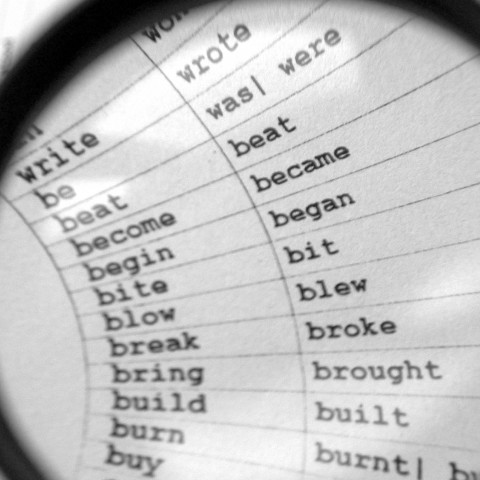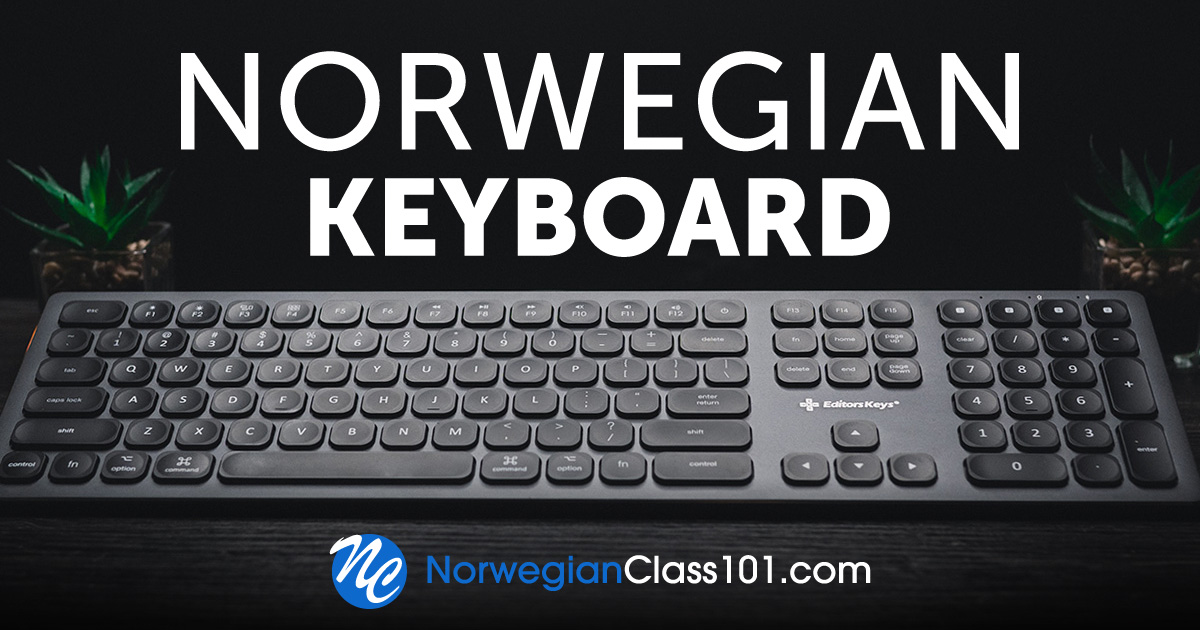
If you’ve read our articles on pronouns and how to tell time, you probably noticed a few verbs here and there. Maybe you even noticed some conjugations of verbs that you had never seen before.
Verbs are essential in mastering a language and communicating in it efficiently. Knowing verbs and how to use them will improve your understanding of Norwegian, both when listening and when speaking.
If you know the most common verbs in Norwegian, it will be easier for you to express yourself and join conversations.
In this article, we’ll cover the 100 most commonly used verbs in Norwegian. In addition to this Norwegian verbs list, we’ll briefly cover the irregular and regular verbs, simple conjugation, and present tense.
If you want to learn how to conjugate verbs and about the different verb groups, be sure to keep an eye out for our upcoming article on this topic.
Are you ready to add some essential Norwegian verbs to your growing vocabulary?
Let’s start!
 Table of Contents
Table of Contents
- The Norwegian Verbs and How They Work
- Action Verbs
- Norwegian Linking Verbs
- Norwegian Modal Verbs
- Making Sentences in Norwegian
- How NorwegianClass101 Can Help You Learn Even More Norwegian!

1. The Norwegian Verbs and How They Work

1 – Regular Verbs are Simple
In this article, we’ll briefly explain what regular and irregular verbs in Norwegian are and how they work. We won’t go into depth, though, as this deserves its own article.
Regular and irregular verbs are common in most languages. Very simply put, regular verbs follow the rules, while irregular verbs don’t.
Usually, the regular Norwegian verbs are put into four verb groups. Which group the verb is in depends on how it’s conjugated, meaning that the verb has a certain ending when conjugated.
The Norwegian regular verbs are grouped with the endings -et, -t, -d, and -dd.
Let’s take a quick look at a regular verb in Norwegian!
Å vaske (“to wash”) — This is the infinitive form.
Vask — This is the stem.
| 1st sg (I) | 2nd sg (you) | 3rd sg (she/he/it) | 1st pl (we) | 2nd pl (you) | 3rd pl (they) |
| Vask + er | Vask + er | Vask + er | Vask + er | Vask + er | Vask + er |
| Vasker | Vasker | Vasker | Vasker | Vasker | Vasker |
Keep in mind that this is only present tense. The verb will still follow a set of rules, but it will change in past tense and present perfect. For example, in past tense, 3rd sg (she) will get an -a ending instead of -et.
This is, however, going to be covered in our article about Norwegian conjugation!
2 – Irregular Verbs are Scary
The Norwegian language has around 300 irregular verbs. In addition to this, the irregular verbs have some grouping, sort of like regular verbs. These are, however, highly irregular, as one might expect.
In Norwegian schools, when learning irregular verbs, we’re normally advised to memorize the irregular verbs since there really are no rules to follow.

Let’s take a quick look at an irregular Norwegian verb as well.
- Å dø (“to die”) — This is the infinitive form.
Dø — This is the stem.
| 1st sg (I) | 2nd sg (you) | 3rd sg (she/he/it) | 1st pl (we) | 2nd pl (you) | 3rd pl (they) |
| Dø + r | Dø + r | Dø + r | Dø + r | Dø + r | Dø + r |
| Dør | Dør | Dør | Dør | Dør | Dør |
In present tense, it looks like the verb å dø has a pattern. However, when you look at the past tense and present perfect, the verb will suddenly look like this:
| Past Tense | Present Perfect |
| Døde | Dødd |
Instead of the regular ending of –et, å dø is getting -de and -dd instead.
And these endings aren’t a rule—many Norwegian irregular verbs will get other endings and completely change their sound. This is why they’re called irregular verbs.
3 – Don’t Worry About Verb Groups Yet!
In this article, we won’t cover the verb groups as this is too much information to put into one article! When learning a language like Norwegian, it’s important to take in a few things at a time so that you don’t get overwhelmed.
When you’ve started to build up your verb vocabulary, it will be easier to learn about the different groups and how they work.
Because of this, we’ll only cover the infinitive form for most of the verbs in this article.
4 – The Most Important Verbs in Norwegian
Before we start our list of 100+ common verbs in Norwegian, we need to cover two very important verbs that are used more than any other verbs in Norwegian.
1. “To be”
Like in English, “to be” is probably the most important and most-used verb in the Norwegian language. This is an irregular verb, as one might expect, and you need to memorize it.
| Infinitive | Preteritum | Presens futurum | Presens perfektum | Preteritum perfektum |
| Å være | Er | Var | Være | Vært |
| “To be” | “Am” | “Was” | “Be” | “Been” |
Examples
Jeg er norsk. “I am Norwegian.”
Jeg var i Norge. “I was in Norway.”
Du har vært i Norge. “You have been in Norway.”
2. “To have”
“To have” is the second most important and commonly used verb in Norwegian. As this is an auxiliary verb, it’s also irregular.
| Infinitive | Preteritum | Presens futurum | Presens perfektum | Preteritum perfektum |
| Å ha | Har | Hadde | Ha | Hatt |
| “To have” | “Have” | “Had” | “Have” | “Had” |
Examples
Jeg har to bøker. “I have two books.”
Jeg hadde dem i går. “I had them yesterday.”
Jeg har hatt det gøy! “I’ve had fun!”
When starting to learn Norwegian language verbs, these two are the most important ones to learn. Memorize them, and you’ll be able to express yourself a lot better than without them. Now that we’ve gone through the two most important verbs, let’s learn the rest!
2. Action Verbs

It’s important to note that verbs are classified differently. We have mental verbs, action verbs, linking verbs, and helping verbs. All of these have their own usage and place in the language.
Action verbs are verbs that express a physical or mental action. In this article, we’ve listed physical action verbs and mental action verbs separately, so you can recognize them easier!
We’ll start with the physical action verbs, which are some of the most useful Norwegian verbs to know as a beginner.
1 – Physical Action Verbs
1.
| Å gå “To go” “To walk” | Jeg vil ikke gå. “I don’t want to walk.” |
2.
| Å løpe “To run” | Jeg skal løpe. “I’m going to run.” |
3.
| Å kjøre “To drive” | Vi skal kjøre til Oslo. “We’re gonna drive to Oslo.” |
4.
| Å stå “To stand” | Vi må stå på bussen. “We have to stand in the bus.” |
5.
| Å sitte “To sit” | Vi kan sitte på bussen. “We can sit in the bus.” |
6.
| Å ligge “To lay” | Hunden skal ikke ligge i sengen. “The dog is not supposed to lay in the bed.” |
7.
| Å legge “To lay” “To put” | Kan jeg legge den her? “Can I lay/put this here?” |
8.
| Å sove “To sleep” | Det var vanskelig å sove igår, det var så mye bråk. “It was hard to sleep yesterday, there was so much noise.” |
9.
| Å danse “To dance” | Skal vi danse i morgen? “Are we going to dance tomorrow?” |
10.
| Å løpe “To run” | Jeg skal løpe. “I’m going to run.” |
11.
| Å trene “To workout” “To train” | Jeg skal trene. “I’m going to work out” Hunden må trene i morgen. “The dog has to train tomorrow.” |
12.
| Å jogge “To jog” | Hun skal jogge etterpå. “She’s gonna jog later.” |
13.
| Å fortelle “To tell” | Hysj, han skal fortelle en historie! “Hush, he’s gonna tell a story!” |
Note: Å fortelle is very often used when telling a story. In other conversations, it’s normal to use the verb å si when you want someone to tell you something or vice-versa.

14.
| Å si “To say” “To tell” | Kan jeg si deg noe? “Can I tell you something?” |
15.
| Å snakke “To talk” | Sjefen sa vi må snakke senere. “The boss said we have to talk later.” |
16.
| Å spørre “To ask” | Kan du spørre når vi skal til Bergen? “Can you ask when we’re going to Bergen?” |
17.
| Å le “To laugh” | Det er så lett å le sammen med deg! “It’s so easy to laugh with you!” |
18.
| Å tulle “To joke” “To be silly” | Jeg skal tulle litt med henne. “I’m going to joke a little with her.” |
Fun fact: Tulle can also be used as a pet name for a baby girl. Normally, this is said as ei lita tulle, which has no official translation, but is close to saying “a cute little (baby) girl.”
Example
For ei søt lita tulle du har! “What a cute little (baby) girl you have!”
19.
| Å skrike “To scream” | Babyen sluttetå skrike. “The baby stopped screaming.” |
Fun fact: In some places in Norway (like Molde), skrike can also mean “to cry.” This can be confusing for both Norwegians and foreigners!
20.
| Å avbryte “To interrupt” | Det er frekt å avbryte andre. “It’s rude to interrupt others.” |
21.
| Å skrive “To write” | Han liker å skrive historier. “He likes to write stories.” |
22.
| Å lese “To read” | Hun skal lese fem bøker. “She’s going to read five books.” |
23.
| Å spille “To play” “To act” “To gamble” “To record” | Kan han spille gitar? “Can he play the guitar?” |
24.
| Å planlegge “To plan” | Skal vi planlegge bursdagen? “Shall we plan the birthday?” |
25.
| Å ringe “To call” “To ring” | Han skal ringe på lørdag. “He’s gonna call on Saturday.” |
26.
| Å møte “To meet” | Hvor mange skal vi møte? “How many are we going to meet?” |
27.
| Å treffe “To meet” “To see” “To hit (a target)” | Hei, hyggelig å treffe deg. “Hi, nice to meet you.” |
28.
| Å hjelpe “To help” | Hun kan hjelpe deg. “She can help you.” |
29.
| Å flytte “To move” | Kan du flytte deg? “Can you move?” |
30.
| Å bo “To live (in a house/town/city)” | Han planlegger å bo i Norge. “He’s planning to live in Norway.” |
31.
| Å besøke “To visit” | Jeg skal besøke Norge. “I’m going to visit Norway.” |
32.
| Å reparere “To repair” | Hun skal reparere bilen. “She’s going to repair the car.” |
33.
| Å bygge “To build” | Vi vil bygge en god fremtid for barna. “We want to build a good future for the children.” |
34.
| Å hogge “To chop” | Jeg skal hogge ved. “I’m going to chop (fire)wood.” |
35.
| Å søke “To apply; seek; search” | Kan du søke på Google? “Can you search on Google?” |
36.
| Å ansette “To hire” | Jeg vil ansette henne. “I want to hire her.” |
37.
| Å jobbe “To work” | Jeg vil ikke jobbe i dag. “I don’t want to work today.” |
38.
| Å bære “To carry” | Kan du bære sekken? “Can you carry the backpack?” |
39.
| Å bistå “To assist” “To aid” | Jeg vil gjerne bistå deg. “I would like to assist you.” |
Note: In most of the cases where you can use bistå, you can also use the verb å hjelpe, which means “to help.”
40.
| Å holde “To hold” | Vil du holde katten? “Do you want to hold the cat?” |
41.
| Å motta “To receive” | Jeg vil gjerne motta prisen. “I would like to receive the prize.” |
42.
| Å velge “To choose” | Jeg klarer ikke velge mellom disse to. “I can’t choose between these two.” |
43.
| Å finne “To find” | Jeg klarte å finne telefonen! “I managed to find the phone!” |
44.
| Å putte/plassere “To put/place” | Kan du putte maten i kjøleskapet? “Can you put the food in the fridge?” |
Note: Putte and plassere mean the exact same thing: “to place” or “put.” Which one you use depends on what you prefer. Plassere is a more proper verb to use compared to putte, which can be more casual.
45.
| Å skaffe “To obtain” “To get” | Hun kan skaffe papirene. “She can obtain the papers.” |
46.
| Å få “To get” “To receive” | Jeg skal få en katt. “I’m gonna get a cat.” |
Note: Å få is also a modal verb!
47.
| Å anta “To assume” “To presume” | Jeg vil anta at han kommer fredag. “I would assume he comes on Friday.” |
48.
| Å se “To see” | Jeg ser deg. “I see you.” |
49.
| Å lage “To make” “To create” | Skal vi lage middag? “Shall we make dinner?” |
50.
| Å spise “To eat” | Han vil spise middag klokken syv. “He wants to eat dinner at seven o’clock.” |
51.
| Å drikke “To drink” | Hun vil ikke drikke på festen. “She doesn’t want to drink at the party.” |
Fun fact: In Norway, we often use å drikke as a way of saying “drinking alcohol” or “getting drunk.” If you’re asked Skal du drikke i kveld? meaning “Are you going to drink tonight?” you’re being asked if you’re planning on getting drunk.
52.
| Å prøve “To try” | Vi kan jo prøve. “We could try.” |
53.
| Å slippe “To let (go)” | Kan du slippe hunden? “Can you let go of the dog?” |
54.
| Å stoppe “To stop” | Bussen skal stoppe snart. “The bus will stop soon.” |
55.
| Å starte “To start” | Vi skal starte møtet snart. “We’re going to start the meeting soon.” |
56.
| Å forlate “To leave” | Vi vil forlate hotellet vårt. “We want to leave our hotel.” |
Note: In place of å forlate, you can also use the verb å dra.
57.
| Å dra “To leave” “To drag” “To go (somewhere)” | Vi vil dra fra hotellet vårt. “We want to leave our hotel.” Vi vil dra til hotellet vårt. “We want to go to our hotel.” |
58.
| Å forsvinne “To disappear” | Sokken kan jo ikke bare forsvinne? “The sock can’t just disappear?” |
59.
| Å ødelegge “To break” | Du kan ikke ødelegge denne. “You can’t break this.” |
60.
| Å fryse “To freeze” | Det er lett å fryse i Norge. “It’s easy to freeze in Norway.” |
61.
| Å brenne “To burn” | Det er lett å få bålet til å brenne. “It’s easy to make the campfire burn.” |
62.
| Å selge “To sell” | Jeg vil selge disse skoene. “I want to sell these shoes.” |
63.
| Å kjøpe “To buy” | Han vil kjøpe hus i Norge. “He wants to buy a house in Norway.” |
64.
| Å leve “To live” “To be alive” | Det er lett å leve! “It’s easy to live!” |
65.
| Å reise “To travel” “To raise” | Jeg vil reise til Norge. “I want to travel to Norway.” |
66.
| Å sende “To send” | Han skal sende en e-post. “He’s gonna send an email.” |
67.
| Å vise “To show” | Kan jeg vise deg noe? “Can I show you something?” |
68.
| Å åpne “To open” | Vil du åpne døra? “Do you want to open the door?” |
2 – Mental Verbs
69.
| Å vite “To know” | Jeg vet ikke. “I don’t know.” |
70.
| Å tenke “To think” | Det er vanskelig å tenke. “It’s hard to think.” |
71.
| Å ville “To want” | Nei, han ville ikke det. “No, he didn’t want that.” |
72.
| Å tro “To believe” | Mange velger å tro på Gud. “Many choose to believe in God.” |
73.
| Å forvente “To expect” | Du kan ikke forvente så mye. “You can’t expect that much.” |
74.
| Å forstå “To understand” | Hvem kan ikke forstå meg? “Who can’t understand me?” |
75.
| Å like “To like” | Hva er det å ikke like? “What’s not to like?” |
76.
| Å elske “To love” | Det er lett å elske deg. “It’s easy to love you.” |
77.
| Å huske “To remember” | Han kan ikke huske noe. “He can’t remember anything.” |
78.
| Å hate “To hate” | Du burde ikke hate andre mennesker. “You should not hate other people.” |
79.
| Å skjønne “To understand” | Det erlettere å skjønne når du blir eldre. “It’s easier to understand when you’re older.” |
80.
| Å ønske “To wish” | Mange kan ønske det samme. “Many can wish the same.” |
81.
| Å overraske “To surprise” | Hun valgte å overraske han! “She chose to surprise him!” |
82.
| Å føle “To feel” | Jeg kan føle det samme. “I can feel the same.” |
83.
| Å bekymre “To worry” | Du må ikke bekymre deg. “You don’t have to worry.” |
84.
| Å håpe “To hope” | Det er jo lov å håpe. “It’s allowed to hope.” |
84.
| Å lære “To learn” | Jeg vil lære norsk. “I want to learn Norwegian.” |
86.
| Å smake “To taste” | Hun vil ikke smake på middagen. “She doesn’t want to taste the dinner.” |
87.
| Å lukte “To smell” | Han kan ikke lukte noe. “He can’t smell anything.” |
88.
| Å høre “To hear” | Jeg kan høre deg. “I can hear you.” |
89.
| Å imponere “To impress” | Han gjorde det for å imponere deg. “He did it to impress you.” |
90.
| Å glemme “To forget” | Det er lett å glemme alle reglene. “It’s easy to forget all the rules.” |
3. Norwegian Linking Verbs
91.
| Å bli “To become” | Jeg vilbli veldig glad om du hjelper meg! “I will become very happy if you help me!” |
92.
| Å hete “To be called” “To be named” | Jeg vil ikke hete Irene! “I don’t want to be named Irene!” |
93.
| Å synes “To think (an opinion)” | Jeg synes at hun er veldigsnill. “I think she’s very nice.” |
94.
| Å kalle “To call (name)” “To be named” | Skal vi kalle katten Mons eller Moms? “Shall we call the cat Mons or Moms?” |

95.
| Å forekomme “To occur” | Det kan forekomme flere gode ting i disse situasjonene. “Multiple good things can occur in these situations.” |
96.
| Å virke “To seem” “To affect” | Det kan virke som at han er sur, men han er egentlig glad. “It can seem like he’s mad, but he’s actually happy.” |
97.
| Å døpes “To baptize” “To name” | Båten skal døpes til Fjorden. “The boat shall be named Fjorden.” |
4. Norwegian Modal Verbs
98.
| Vil “To want” | Jeg vil prate med henne. “I want to talk with her.” |
99.
| Skal “Shall/Should” | Han skal komme om to timer. “He should/shall come in two hours.” |
Note: The modal verb skal is one of the most commonly used verbs in Norwegian!
100.
| Å måtte “Must” “Have/Had to” | Jeg måtte rope så han kunne høre meg. “I had to yell so he could hear me.” |
101.
| Å la “To let” | Kan du la meg gå først? “Can you let me go first?” |
102.
| Å kunne “Could” “May” | Jeg kunne danse før. “I could dance before.” |
103.
| Burde “Should” | Han burde ha sagt ifra. “He should have said so.” |
104.
| Å ville “Will” (desire to do something) | Jeg vil prate med deg. “I want to talk with you.” |
5. Making Sentences in Norwegian

Now that you’ve learned many new verbs, you’re probably wondering where you place them in sentences.
Now, we’ll go briefly through the basic sentence structure in Norwegian. If you need a little refresher, you can look at our lesson on the Norwegian Basics.
The basic sentence structure in Norwegian is S + V + O.
However, two verbs are often placed next to each other. Further, sentences can be started in a number of different ways in Norwegian, but the verb is very often the second word.
1 – Examples

6. How NorwegianClass101 Can Help You Learn Even More Norwegian!
In this article, we went through the 100+ most common and important verbs in the Norwegian language. We also went through basic information on regular verbs, irregular verbs, verb groups, and of course the two most important verbs in Norwegian!
By now, you’ve learned the different types of Norwegian verbs so you can express yourself properly. Knowing these verbs will also make it easier for you to follow conversations.
At NorwegianClass101, we have even more articles that will help you become fluent in the Norwegian language! If you’re traveling in Norway, we have a great list for verbs to use when traveling. We also recommend reading our article on strategies for learning Norwegian grammar.
Like we’ve said, learning Norwegian verbs and sentence structure will help you immensely on your language-learning journey. Verbs are one of the most important things to learn when working towards total mastery!
But verbs are only one part of speech. For this reason, we have great articles on both nouns and adjectives that you can study as well. Combine your knowledge of verbs with this, and you’ll be making sentences on your own in no time.
NorwegianClass101 has materials for both beginners and advanced students, so no matter where you are in your learning curve, you’ll find something that can help you on your way to mastering the Norwegian language.
Before you go, let us know in the comments what you think about Norwegian verbs! Do you feel more confident now, or are you still struggling with something? To practice, write us a few sentences in the comments section using the new verbs you learned! 🙂 We look forward to hearing from you!









